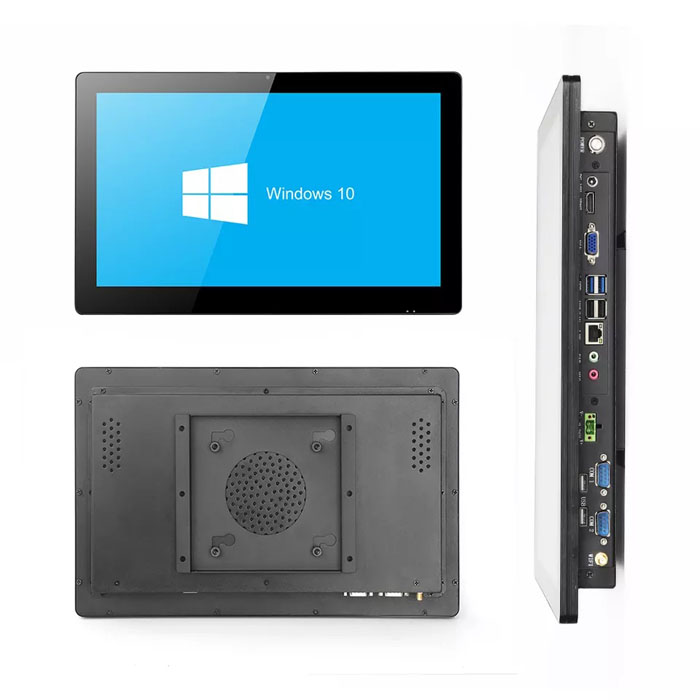Industrial LCD monitors are integral to various applications across multiple industries, where their specialized features provide significant advantages.
Here are some examples of industrial applications that require the unique capabilities of industrial LCD monitors:
1. Manufacturing Automation
Application: Assembly Line Monitoring
- Specialized Features Needed:
- Rugged Construction: To withstand dust, vibration, and potential impacts in a manufacturing environment.
- Touchscreen Interface: For operators to easily interact with the control systems.
- High Brightness and Contrast: To ensure visibility in different lighting conditions within the factory.
Example: A monitor on an automotive assembly line used to display real-time data and alerts, allowing operators to monitor production metrics and troubleshoot issues promptly.
2. Oil and Gas Industry
Application: Drilling Rig Monitoring
- Specialized Features Needed:
- Explosion-Proof Design: To ensure safety in hazardous environments with flammable gases.
- Wide Temperature Range: To operate reliably in extreme temperatures typical of oil rigs.
- High Durability: To withstand harsh outdoor conditions, including salt spray and heavy machinery vibrations.
Example: Monitors used on offshore drilling platforms to provide real-time data on drilling operations, helping operators to make informed decisions and ensure safety.
3. Healthcare and Medical Devices
Application: Operating Room Displays
- Specialized Features Needed:
- High Resolution: For precise and clear visualization of medical images and patient data.
- Hygienic Design: Easy to clean and often with antimicrobial surfaces to maintain sterility.
- Touchscreen Functionality: For surgeons and medical staff to interact with the display without physical buttons.
Example: Monitors used to display patient vitals and surgical images during operations, providing surgeons with critical information in real-time.
4. Transportation and Logistics
Application: Vehicle-Mounted Displays
- Specialized Features Needed:
- Ruggedized Design: To withstand shocks, vibrations, and temperature variations encountered in vehicles.
- Sunlight Readable Screens: High brightness and anti-glare screens for visibility in direct sunlight.
- Wireless Connectivity: To enable real-time data communication and GPS integration.
Example: Monitors mounted in delivery trucks and forklifts for navigation, tracking inventory, and receiving updated delivery instructions.
5. Military and Defense
Application: Field Command Centers
- Specialized Features Needed:
- Ruggedized and Portable: To endure harsh field conditions and easy to transport.
- Secure and Reliable: Meets military standards for data security and operational reliability.
- Wide Viewing Angles: So multiple personnel can view the display simultaneously.
Example: Portable monitors used in tactical command centers to provide real-time situational awareness, maps, and communication with field units.
6. Energy and Utilities
Application: Power Plant Control Rooms
- Specialized Features Needed:
- High Reliability: Continuous operation without downtime is critical.
- Wide Viewing Angles: Allows multiple operators to monitor systems concurrently.
- Multiple Input Options: To integrate with various sensors and control systems.
Example: Monitors in control rooms to oversee power generation and distribution, displaying complex data from multiple sources to ensure efficient and safe operations.
7. Retail and Digital Signage
Application: Interactive Kiosks
- Specialized Features Needed:
- Touchscreen Interactivity: For customer engagement and self-service applications.
- Durability: Designed for continuous use in high-traffic areas.
- High Brightness: To remain visible under various lighting conditions.
Example: Kiosks in shopping malls or airports providing wayfinding, ticket purchasing, or promotional information to customers.
8. Public Safety and Emergency Services
Application: Emergency Operations Centers (EOC)
- Specialized Features Needed:
- High Reliability and Uptime: Essential during emergency situations.
- Large Format Displays: For viewing multiple data streams and video feeds simultaneously.
- Touchscreen and Interactive Capabilities: For quick access and manipulation of information.
Example: Monitors in EOCs displaying live feeds from surveillance cameras, weather updates, and communication channels to coordinate emergency response efforts.
Industrial LCD monitors are designed to meet the demanding requirements of various industrial applications, providing ruggedness, reliability, and advanced features necessary for effective operation in harsh environments. From manufacturing and oil rigs to healthcare and military operations, these monitors play a critical role in ensuring operational efficiency, safety, and accuracy across industries.

